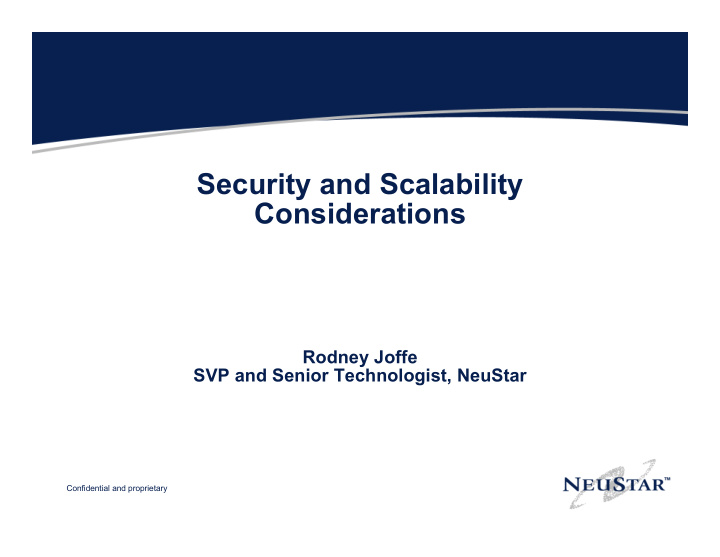



Security and Scalability Considerations Rodney Joffe SVP and Senior Technologist, NeuStar Confidential and proprietary
Introduction A Registry is much more than a database and software; it includes: • Network infrastructure – firewalls, load balancers, routers, packet shapers • Protocol and application servers • DNS and WHOIS servers • Billing systems • Monitoring systems • Security and intrusion detection systems Must be designed and managed with security, stability, and robustness in mind Must be supported by comprehensive security and contingency plans Confidential and proprietary 2
Data and Infrastructure Security What does a Registry need to protect? • SRS Database • WHOIS Database • DNS Infrastructure • Billing and Financial Systems • Web Servers • Customer Relationship Management Systems Confidential and proprietary 3
Security Management Areas of Consideration: Security Policy Security Organization Personnel Security Policies Physical and Environmental Security Operations and Communications Entitlements Management (Info access) System development and Maintenance (Production Support) Security Incident Management Continuity of Business (COB) Auditing Confidential and proprietary 4
Security Mitigation Strategies • Multiple Firewall Layers • Intrusion Detections Systems • No direct access to the database • Multiple control mechanisms to manage registrar connectivity – IP addresses; passwords, and certificates • Registrar connections should be managed by dedicated packet shaping hardware • File level access controls • Regular internal and third-party audits Confidential and proprietary 5
Registry Architecture Confidential and proprietary 6
Scalability – Areas of Consideration • Network Infrastructure • Internet Bandwidth • Database • Protocol and Application Servers • DNS Network • WHOIS Databases • Registrar Connectivity • Billing and Financial Systems • OT&E Environment Confidential and proprietary 7
Scalability Strategies • High availability, redundant network – Hot stand-by data centers – No single points of failure • Architectural design that is scalable – Load balanced server farms – Separate protocol and application server layers • Enterprise grade software (Oracle, etc) • Broad Global DNS Network • Multiple ISP Connections • Pre-established contingency plans Confidential and proprietary 8
System Monitoring • System and resource monitoring is necessary for proper planning • Critical resource monitoring includes: – Storage capacity – CPU usage – Memory usage – Data throughput – Internet capacity – Power supply – Availabiliyt • 24 X 7 Network Operations Center and Network Monitoring System – Monitor for Security Breaches – Detect infrastructure and hardware issues – Timely response and coordination Confidential and proprietary 9
DNS and Monitoring Infrastructure UltraDNS Data Centers • Americas • California • Florida • Illinois • New York • Texas • Virginia • Brazil • Peru • Canada • Europe • Luxembourg • London • Amsterdam • Africa • Johannesburg • Asia-Pacific • Beijing • Hong Kong Current Planned Webmetrics • Noida (India) • Sydney 10 Confidential and proprietary 10
Confidential and proprietary
Recommend
More recommend